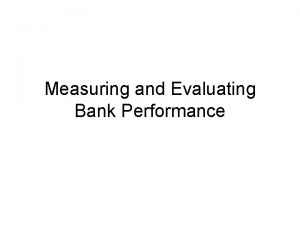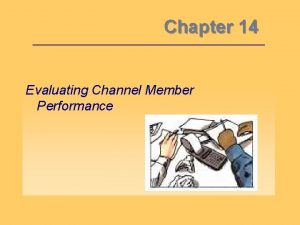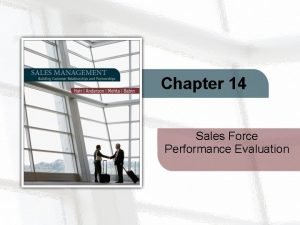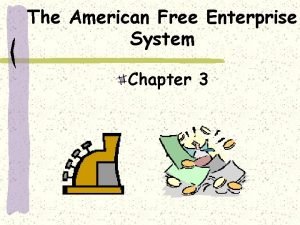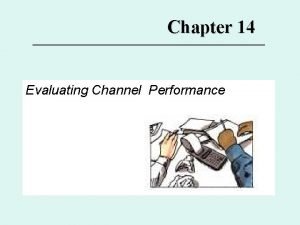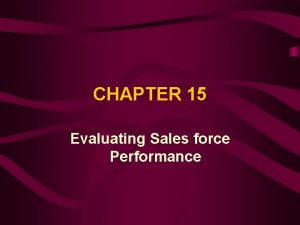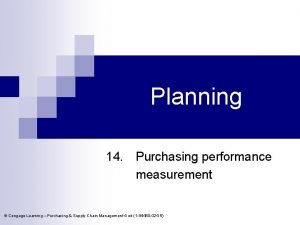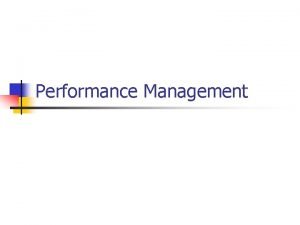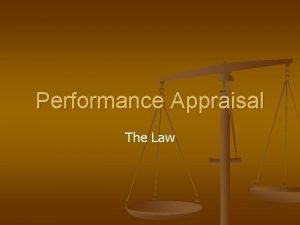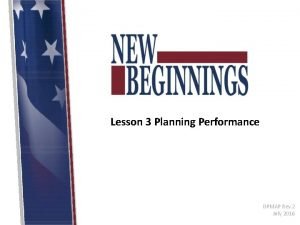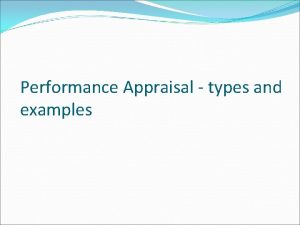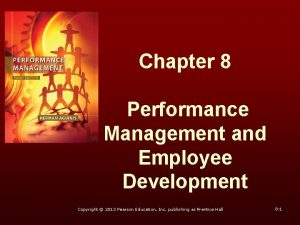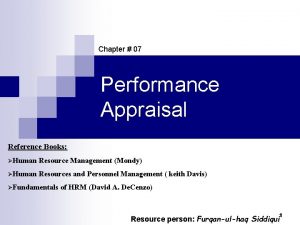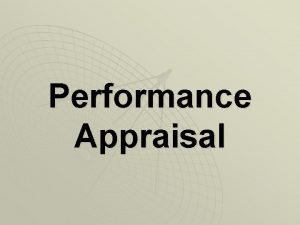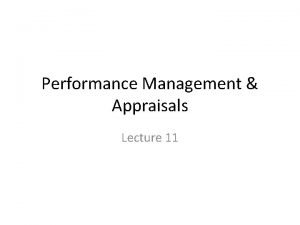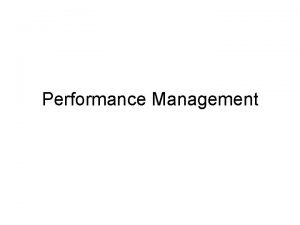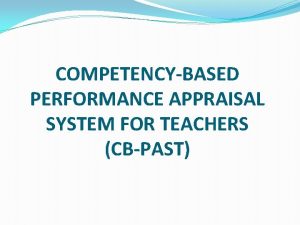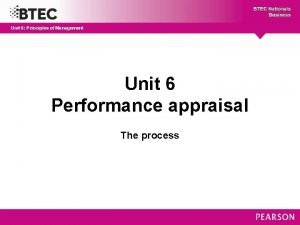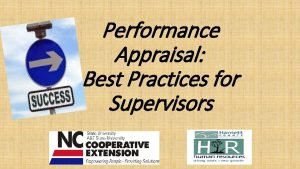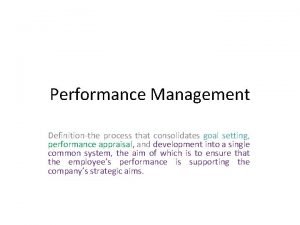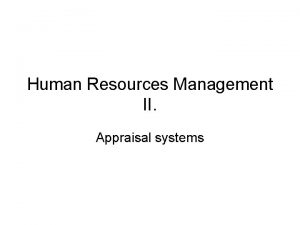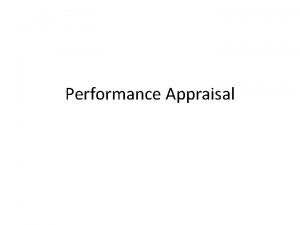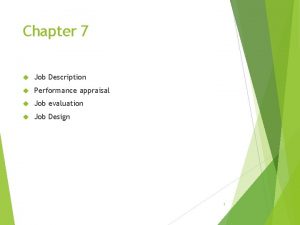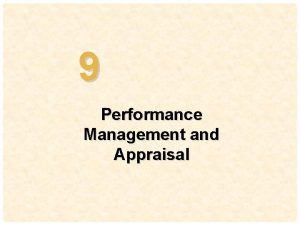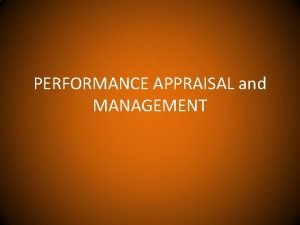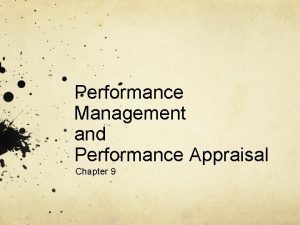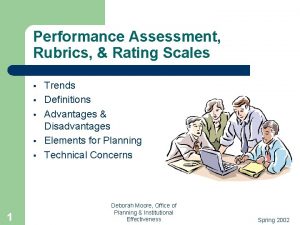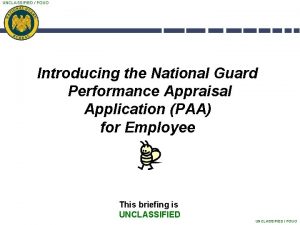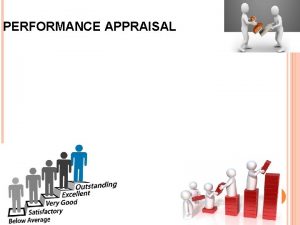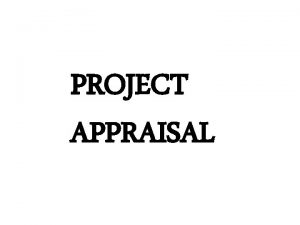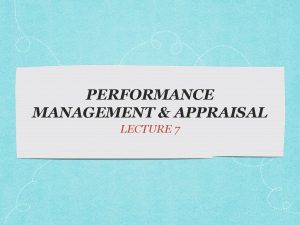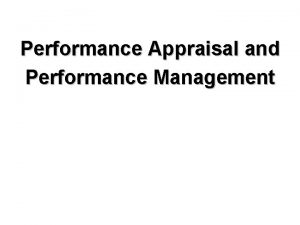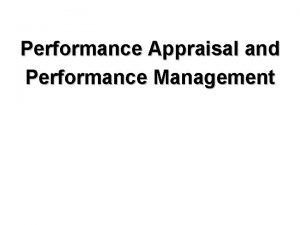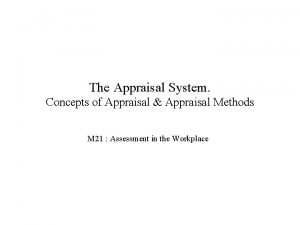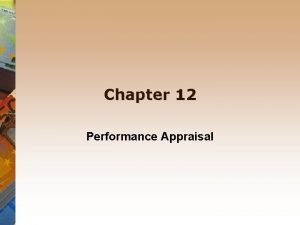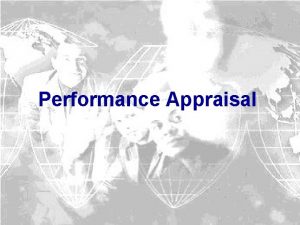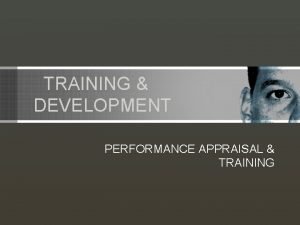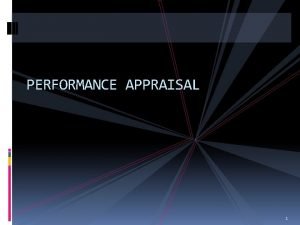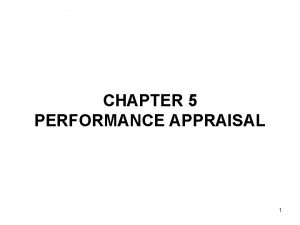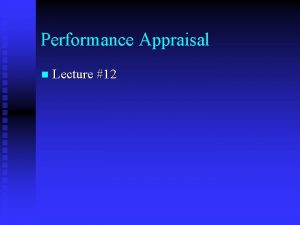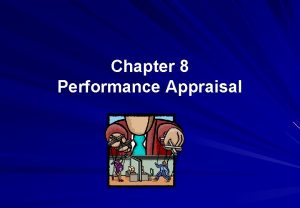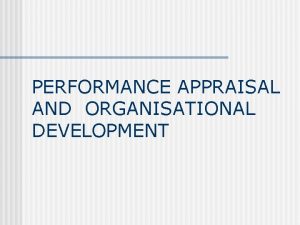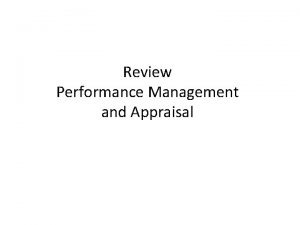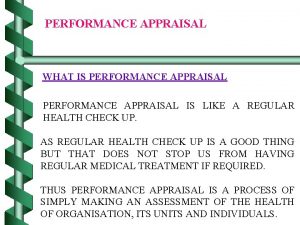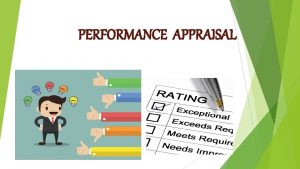Performance Appraisal Performance Appraisal Performance appraisal Evaluating an








































- Slides: 40

Performance Appraisal

Performance Appraisal • Performance appraisal – Evaluating an employee’s current and/or past performance relative to his or her performance standards. • Performance management – The process employers use to make sure employees are working toward organizational goals.

Needs & Objectives • • • Provide database Diagnose the S & W of individuals Provide feedback about employees Provide coaching, counseling, career planning to subordinates Employer’s salary raise decisions Promotion decisions Training & development programmes Develop positive relation and reduce grievance Facilitates research in personnel management

Why Appraisals Are Important • • Recognize accomplishments Guide progress Improve performance Review performance Set goals Identify problems Discuss career advancement

Steps in performance appraisal Establishing job standards Designing an appraisal programme Appraise performance Performance interview Use appraisal data For appropriate purpose

Performance Appraisal Process • • • Setting Performance Standards Communicating standards Measuring standards Comparing standards Discussing results Taking corrective standards

Performance Appraisal Roles • Supervisors – – Usually do the actual appraising. Must be familiar with basic appraisal techniques. Must understand avoid problems that can cripple appraisals. Must know how to conduct appraisals fairly. • HR department – Serves a policy-making and advisory role. – Provides advice and assistance regarding the appraisal tool to use. – Prepares forms and procedures and insists that all departments use them. – Responsible for training supervisors to improve their appraisal skills. – Responsible for monitoring the system to ensure that appraisal formats and criteria comply with EEO laws and are up to date.

Designing the Appraisal Tool • What to measure? – Work output (quality and quantity) – Personal competencies – Goal (objective) achievement • How to measure? – Graphic rating scales – Alternation ranking method – MBO

Performance Appraisal Methods Individual evaluation methods Confidential report Essay evaluation Critical incidents Checklists Graphic rating scale Behaviourally anchored rating scales Forced choice method MBO Multiple-person evaluation methods Ranking Paired comparison Forced distribution Other methods Group Appraisal HRA Assessment centre Field review

• Individual Evaluation Methods § § § § Confidential report Essay evaluation Critical incidents Checklists Graphic rating scale Behaviorally anchored rating scale MBO

• Confidential Report – Mostly used in govt. organisation – Employee’s immediate superior prepare report at the end of the year – Report highlights the strengths & weakness of employee’s

• Essay evaluation – Rater express strong & weak points of employee's behavior – This technique used with combination of graphic rating scale – Rater considers: • Job knowledge & potential • Understanding of company’s programmes, policies & objectives • Employee’s relations with others • Employee’s planning, organizing & controlling ability

• Critical Incident Technique – Critical incidents or events represent the outstanding or poor performance of employees – Manager maintains logs on critical incidents of worker’s behavior • Ex: A fire, sudden breakdown, accident • Workers reaction a) informed the supervisor immediately b) become anxious on loss of output c) tried to repair the machine d) complained for poor maintenance scale 5 4 3 2

• Checklist method § Simple checklist method § Set of statements about employee & his behaviour § Weighted checklist method § Questions may weighted equally or certain questions may be weighted heavily Simple checklist method: Is employee regular Is employee respected by subordinate Is employee helpful Does he follow instruction Does he keep the equipment in order Y/N Y/N Y/N

Weighted checklist method Weights performance rating(scale 1 to 5 ) Regularity 0. 5 Loyalty 1. 5 Willing to help 1. 5 Quality of work 1. 5 Relationship 2. 0

• Graphic Rating Scale Printed form, as shown below is used to evaluate the performance of employee. – Continuous Rating Scale – Discontinuous Rating Scale Employee name_____ Dept. ______ Rater’s name______ Date_______ -------------------------------------------Exc. Good Acceptable Fair Poor 5 4 3 2 1 Dependability Initiative Overall output Attendance Attitude Cooperation Total score

• BARS ( Behaviorally Anchored Rating Scale) – Also known as Behavioural Expectations Scale – It represents latest innovation in performance appraisal – It is the combination of the rating scale & critical incident techniques of employee performance evaluation • • • Step 1 Step 2 Step 3 Step 4 Step 5 Identify critical incidents Select performance dimension Retranslate the incidents Assign scales to incidents Develop final instrument

Example of a Behaviorally Anchored Rating Scale for the Dimension Salesmanship Skill Source: Walter C. Borman, “Behavior Based Rating, ” in Ronald A. Berk (ed. ), Performance Assessment: Methods and Applications (Baltimore, MD: Johns Hopkins University Press, 1986), p. 103.

• Forced choice method It is developed to eliminate bias & high ratings in some organization. Purpose of this method is to correct the tendency of a rater to give consistently high or low ratings to all the employees. Criteria Rating 1. Regularity on the job Most Least Always regular Inform in advance for delay Never regular Remain absent Neither regular nor irregular

• Management by Objectives (MBO) 1. 2. 3. 4. 5. 6. Involves setting specific measurable goals with each employee and then periodically reviewing the progress made. Set the organization’s goals. Set departmental goals. Discuss departmental goals. Define expected results (set individual goals). Performance reviews. Provide feedback.

• Multiple - person evaluation methods § Ranking § Paired comparison § Forced distribution

• Ranking method Relatively easy method Ranking of an employee in a work group is done against that of another employee in terms of his or her numerical rank. Employee A B C D E Rank 2 1 3 5 4

• Paired comparison method Each employee is compared with all other employees in the group for every trait. A B C D E A + + - B + - C - D + + + - E + + - Final Rank 3 2 1 4 5

Ranking Employees by the Paired Comparison Method Note: + means “better than. ” − means “worse than. ” For each chart, add up the number of 1’s in each column to get the highest-ranked employee.

• Forced distribution method – Similar to grading on a curve; predetermined percentages of ratees are placed in various performance categories. – Example: No. of Employees 10% 20% 40% 20% 10% Forced distribution curve

• Other methods § § Group appraisal HRA Assessment centre Field review

• Group Appraisal – Employee is appraised by group of appraisers – immediate supervisor , other supervisor, manager & consultants. – Manager may be Chairman & supervisor may be Coordinator

• Human Resource Accounting – The cost of human resources can be taken as the standard – Employee performance can be measured in terms of employee contribution to the organization. – Employee performance can be taken as positive when contribution is more than the cost & viewed as negative if cost is more than contribution. – Percentages can be ranked to ‘Zero Level’ as shown in the Table.

HRA Rank Rating Percentage of Surplus / Deficit of contribution to cost of employee 1 Extremely good performance Over 200 2 Good performance 150 – 200 3 Slightly good performance 100 – 150 4 Neither poor nor good 5 Slightly poor performance 6 Poor performance 7 Extremely poor performance 0 – 100 0 0 to (-50) to (-100)

• Assessment centre – First applied in German Army in 1930 – It is a system where assessment of several individuals is done by various experts using various techniques include the methods – inbasket, role playing, case studies, simulation exercises etc. – It is basically meant for evaluating the potential of candidates for promotion, training or development in an objective way.

• Field Review Method – To avoid the rater’s biases this method is used. – Trained & skilled representative of HR dept. goes into the ‘field and assists line supervisors with their ratings of their respective subordinates. – HR specialist requests from the immediate supervisor specific information about the employees performance. – Based on this information, expert prepares a report which is sent to the supervisor for review, changes, approval & discussion with the employee who is being rated. – The ratings done on standardized forms.

Computerized and Web-Based Performance Appraisal • Performance appraisal software programs – Keep notes on subordinates during the year. – Electronically rate employees on a series of performance traits. – Generate written text to support each part of the appraisal. • Electronic performance monitoring (EPM) – Having supervisors electronically monitor the amount of computerized data an employee is processing per day, and thereby his or her performance.

360 -Degree Feedback • Also called “Multisource Assessment” • Ratings are collected “all around” an employee from supervisors, subordinates, peers, & customers. • Ex. SBI, WIPRO, Infosys

Problems in performance appraisal • Unclear standards – An appraisal that is too open to interpretation. • Errors in rating • • Halo effects Central tendency Strictness/leniency Stereotyping Constant error Personal bias Spill over effect

• • • Incompetence Negative approach Multiple objectives Resistance Lack of knowledge

How to Avoid Appraisal Problems • Learn and understand the potential problems, and the solutions for each. • Use the right appraisal tool. • Train supervisors to reduce rating errors. • Have raters compile positive and negative critical incidents as they occur.

Essentials of an Effective Appraisal q Mutual trust q Clear objectives q Standardizations q Training q Job relatedness q Documentation q Feedback and participation q Individual differences q Post appraisal review q Review and appeal

Who Should Do the Appraising? • • • The immediate supervisor Peers Rating committees Self-ratings Subordinates 360 -Degree feedback

The Appraisal Interview • Appraisal Interview – An interview in which the supervisor and subordinate review the appraisal and make plans to remedy deficiencies and reinforce strengths. • Types of appraisal interviews – Satisfactory—Promotable – Satisfactory—Not promotable – Unsatisfactory—Correctable – Unsatisfactory—Uncorrectable

• How to conduct the appraisal interview – Talk in terms of objective work data. – Don’t get personal. – Encourage the person to talk. – Don’t tiptoe around. • How to handle a defensive subordinate • How to criticize a subordinate • How to ensure the interview leads to improved performance • How to handle a formal written warning – Purposes of the written warning
 Bars rating scale
Bars rating scale Performance levels
Performance levels Measuring and evaluating bank performance
Measuring and evaluating bank performance Evaluating channel member performance
Evaluating channel member performance Evaluating sales performance
Evaluating sales performance Exiberated
Exiberated Behaviorally anchored rating scale for salesperson
Behaviorally anchored rating scale for salesperson The american free enterprise system lesson 1 answer key
The american free enterprise system lesson 1 answer key Criteria for evaluating channel members
Criteria for evaluating channel members Evaluating sales force performance
Evaluating sales force performance Purchasing performance evaluation
Purchasing performance evaluation Pirl in performance appraisal
Pirl in performance appraisal Direction sharing performance management
Direction sharing performance management What is performance appraisal
What is performance appraisal Legal issues in performance appraisal
Legal issues in performance appraisal Dpmap smart examples
Dpmap smart examples Forced choice method of performance appraisal
Forced choice method of performance appraisal Performance appraisal of international employees
Performance appraisal of international employees Civil service performance appraisal examples
Civil service performance appraisal examples Performance management and appraisal chapter 8
Performance management and appraisal chapter 8 Goda plan
Goda plan Performance appraisal reference books
Performance appraisal reference books Method of performance appraisal
Method of performance appraisal Unclear standards in performance appraisal
Unclear standards in performance appraisal Relative standards performance appraisal
Relative standards performance appraisal Cbpast
Cbpast Principles of performance evaluation
Principles of performance evaluation Appraisal best practices
Appraisal best practices Absolute and relative performance appraisal methods
Absolute and relative performance appraisal methods Types of appraisal methods in hrm
Types of appraisal methods in hrm Upenn performance appraisal
Upenn performance appraisal Appraisals definition
Appraisals definition Udel performance appraisal
Udel performance appraisal Performance appraisal job description
Performance appraisal job description Traditional method of performance appraisal
Traditional method of performance appraisal Apprasol
Apprasol Performance appraisal process
Performance appraisal process Unclear standards in performance appraisal
Unclear standards in performance appraisal Types of performance appraisal ppt
Types of performance appraisal ppt Intrinsic rewards are psychic and self-granted
Intrinsic rewards are psychic and self-granted Mybiz performance appraisal
Mybiz performance appraisal


